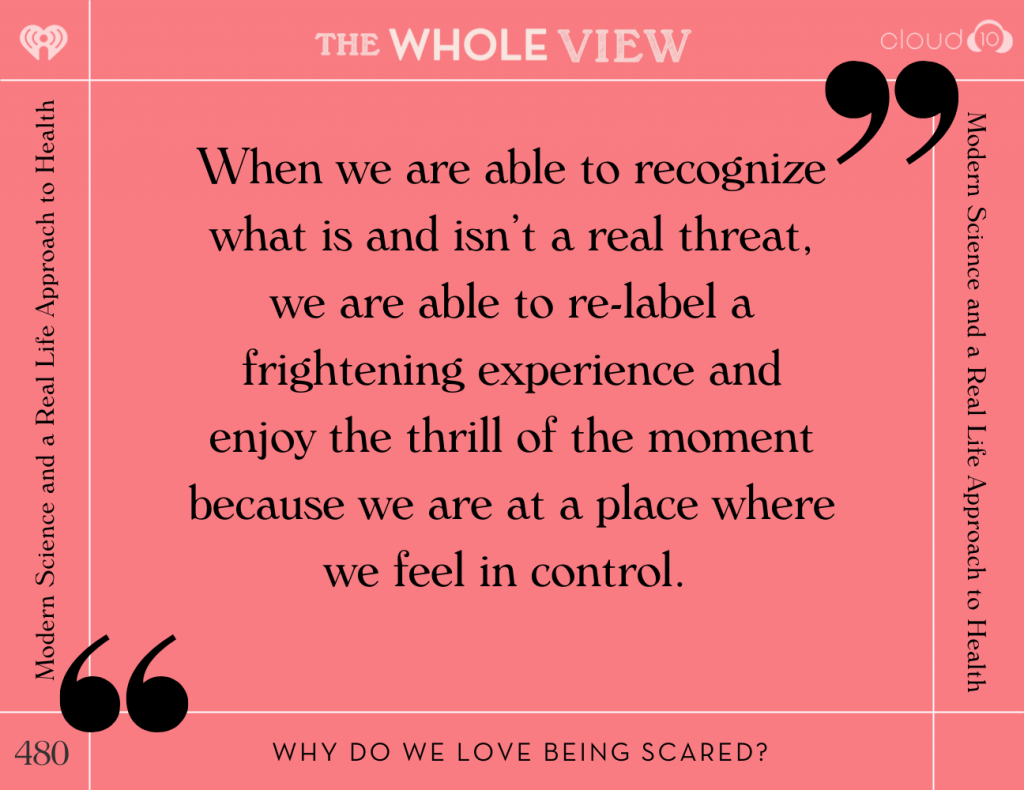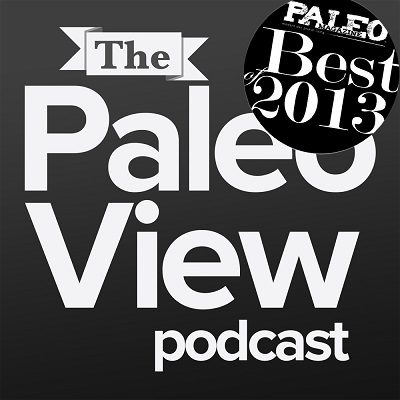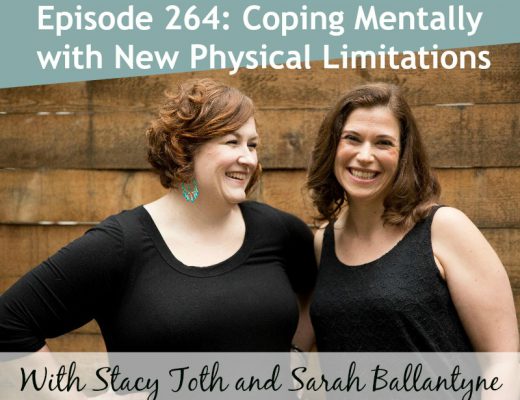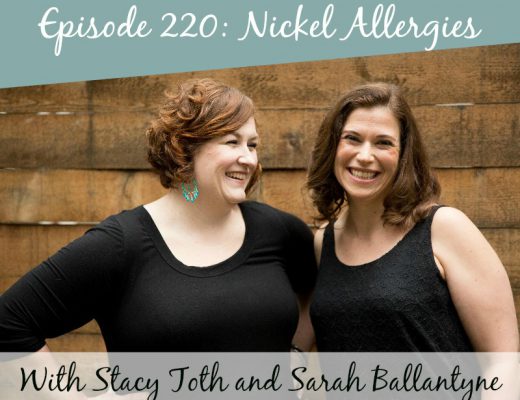
Welcome to episode 480 of The Whole View! This week, Stacy and Dr. Sarah look at the science behind being scared to determine what causes fear and why some people like it more than others.
If you enjoy the show, please review it on iTunes!
The Whole View, Episode 480: Why Do We Love being Scared? True Crime, Horror Movies, and Adrenaline
Why do we like to feel scared? (0:48)
Whether by watching scary movies, true crime or thrill-seeking, skydiving, bungee jumping, roller coasters.
When we experience a threat or crisis, the hormonal reaction we get can motivate a love of being scared. And that’s what Stacy and Dr. Sarah are going to dig into today!
The moment we feel threatened, we feel increasingly more powerful physically and more intuitive emotionally.
This charge to our physical and mental state is called an “adrenaline rush,” As humans, we are hard-wired to be drawn to this type of feeling.
The Biology of Fear
- https://www.ncbi.nlm.nih.gov/pmc/articles/PMC3181681/
- https://www.ncbi.nlm.nih.gov/pmc/articles/PMC3055445/
The fear response starts in a region of the brain called the amygdala. (4:01)
The amygdala plays a role in emotional processing. It monitors the body’s reactions to the environment, evaluates an event’s emotional significance, and organizes responses that a person may or may not be conscious of. It also initiates a fast response to danger.
If the amygdala perceives danger, it sends a signal to the hypothalamus.
The hypothalamus is the command center of the brain. It communicates with the rest of the body through the autonomic nervous system and hormones signals to the pituitary gland.
The autonomic nervous system controls involuntary body functions like breathing, blood pressure, heartbeat, and the dilation or constriction of key blood vessels and small airways in the lungs called bronchioles.
Two components:
- The sympathetic nervous system functions like a gas pedal in a car. It triggers the fight-or-flight response, providing the body with a burst of energy so that it can respond to perceived dangers.
- The parasympathetic nervous system acts like a brake. It promotes the “rest and digest” response that calms the body down after the danger has passed.
The Amygdala
When the amygdala tells the hypothalamus that there’s danger, the hypothalamus transmits a signal to the adrenal medulla through the autonomic nerves. (9:10)
When the adrenal glands receive the signal, they respond by releasing adrenaline and noradrenaline into the bloodstream.
This leads to bodily changes that prepare us to be more efficient in a danger:
- The brain becomes hyperalert
- pupils dilate
- The bronchi dilate, and breathing accelerates
- Heart rate and blood pressure rise
- Blood flow and stream of glucose to the skeletal muscles increase.
- Organs not vital in survival (such as the gastrointestinal system) slow down
And, here’s where our thinking brain kicks in! A part of the brain called the hippocampus is closely connected with the amygdala.
Hippocampus & Prefrontal
The hippocampus and prefrontal cortex help the brain interpret the perceived threat. This is where the higher-order thinking/executive function takes place. (10:15)
They are involved in a higher-level processing of context, which helps a person know whether a perceived threat is real.
For instance, seeing a lion in the wild can trigger a strong fear reaction, but the response to a view of the same lion at a zoo is more of curiosity and thinking that the lion is cute.
The hippocampus and the frontal cortex process contextual information, and inhibitory pathways dampen the amygdala fear response and its downstream results.
Our “thinking” circuitry of the brain reassures our “emotional” areas that we are, in fact, OK.
Stick a pin in this because we’re going to come back to it!
Fear and Safety
Also, we can learn fear and safety! (11:55)
Like other animals, we often learn fear through personal experiences, such as being attacked by an aggressive dog or observing other humans attacked by an aggressive dog. Source
However, an evolutionarily unique and fascinating way of learning in humans is through instruction – we learn from spoken words or written notes!
If a sign says the dog is dangerous, proximity to the dog will trigger a fear response. Source
We similarly learn safety: experiencing a domesticated dog, observing other people safely interact with that dog, or reading a sign that the dog is friendly.
When that fear persists, the hypothalamus also initiates the stress response via HPA axis activation.
The autonomic nervous system signal is faster than the hormone signal from the HPA axis, but that’s activated too!
If the brain continues to perceive something as dangerous, the hypothalamus releases corticotropin-releasing hormone (CRH), which travels to the pituitary gland.
This triggers the release of adrenocorticotropic hormone (ACTH), which travels to the adrenal glands, prompting them to release cortisol.
The body thus stays revved up and on high alert. When the threat passes, cortisol levels fall. The parasympathetic nervous system — the “brake” — then dampens the stress response.
Beyond Cortisol and CRH
Last week, we talked about the effects of chronic stress and the HPA axis, focusing primarily on the role of cortisol as the master stress hormone.
But one of the things that we didn’t discuss is the other hormones released by the adrenal glands that are relevant to the fight or flight response!
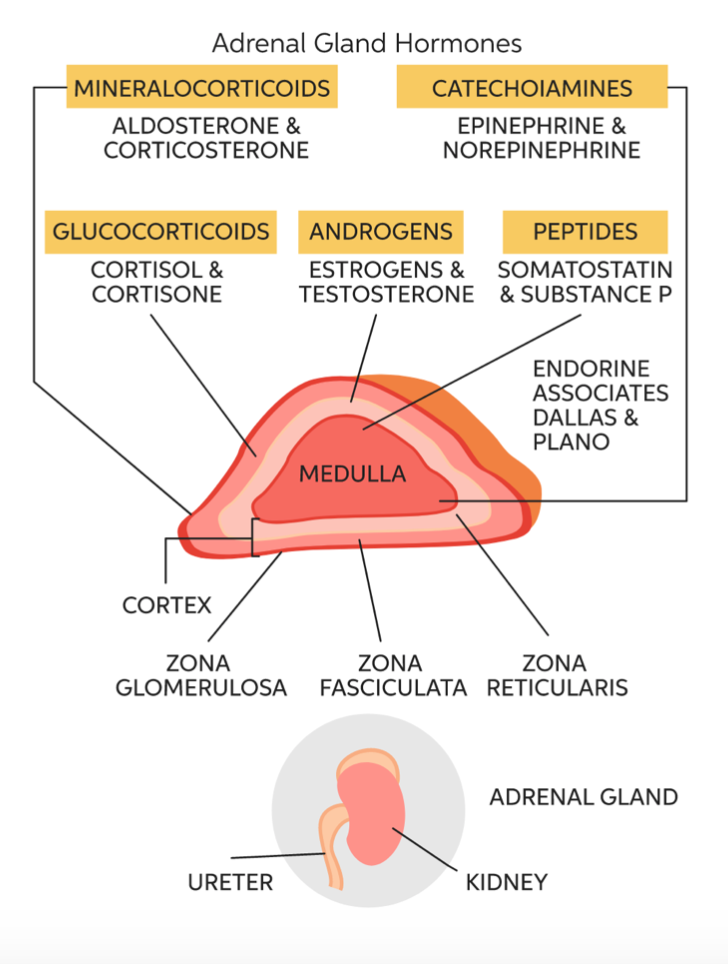
Adrenal glands produce many hormones, including aldosterone, Dehydroepiandrosterone (DHEA), cortisol, adrenaline, and noradrenaline.
Aldosterone plays an important role in regulating blood pressure and the body’s sodium and potassium levels.
It sends signals to the kidneys to absorb sodium and release potassium through urine, regulating blood pressure and the number of electrolytes in the body.
DHEA is a naturally occurring steroid hormone that converts into a range of hormones, including androgens and estrogens, the male and female sex hormones.
Adrenaline and noradrenaline come from a nervous signal to adrenals, and that signal releases cortisol.
Adrenaline & Noradrenaline
These are also called Epinephrine and Norepinephrine.
Adrenaline is also known as the “fight-or-flight hormone.” It releases QUICKLY in response to a stressful, exciting, dangerous, or threatening situation.
Adrenaline helps your body react more quickly. For example, it makes the heart beat faster, increases blood flow to the brain and muscles, and stimulates the body to make sugar to use for fuel.
Once in the bloodstream, adrenaline binds to receptors on liver cells to break down larger sugar molecules, called glycogen, into a smaller, more readily usable sugar called glucose; this gives your muscles a boost of energy.
Adrenaline also binds to receptors on muscle cells in the lungs, causing you to breath faster, stimulating heart cells to beat faster, and triggering the blood vessels to contract and direct blood toward major muscle groups.
It contracts muscle cells below the skin’s surface to stimulate perspiration and binds to receptors on the pancreas to inhibit the production of insulin.
Norepinephrine, also called noradrenaline, has effects similar to those of epinephrine, such as increased:
- blood sugar levels
- heart rate
- blood vessel contractility, which increases blood pressure.
As an interesting aside, the release of norepinephrine via amygdala activation may represent a key component of the transition to dependence and addiction.
For more, see Brain stress systems in the amygdala and addiction.
What Is an Adrenaline Rush?
The bodily changes that occur as adrenaline and noradrenaline circulate throughout the blood- sometimes called an adrenaline rush because these changes happen rapidly. (36:30)
An adrenaline rush is a boost of energy. Other positive symptoms include:
- heightened senses
- decreased ability to feel pain
- increased strength and performance
After the stress or danger is gone, the effect of adrenaline can last up to an hour.
Endorphins
Another hormone neurotransmitter that’s responsible for the positive associations with being scared is endorphins.
Endorphins release due to shock, freeze, “fight or flight,” trauma, physical pain, and all stress, including psychological stress.
They serve as an analgesic (painkilling) anesthetic and cause dissociation, immobilization, and loss of self. Endorphins block pain, but they’re also responsible for our feelings of pleasure.
Endorphins release with ACTH in response to any stressor and produce as a response to certain stimuli, especially stress, fear, or pain.
They originate in various parts of your body — the pituitary gland, your spinal cord, and throughout other parts of your brain and nervous system — and interact mainly with receptors in cells found in regions of the brain responsible for blocking pain and controlling emotion.
There are at least 20 different kinds of endorphins. One kind, beta-endorphins, is stronger than morphine and has been shown to play a part in everything from alcoholism to diabetes to the brain’s aging.
Emotions
The majority of your emotions (and memories) are processed by your brain’s limbic system, including the hypothalamus. This region handles a range of functions from breathing and sexual satisfaction to hunger and emotional response.
The limbic system is also rich in opioid receptors.
When endorphins reach the opioid receptors of the highly emotional limbic system, and — if everything is working normally — you experience pleasure and a sense of satisfaction.
One example is “runner’s high.” Running produces a flood of endorphins. When people experience an injury in the heat of sports competition or battle, they often don’t notice their injury until the action stops.
Mood changes and endorphins are also linked.
It’s not unusual for an avid runner to start running regularly for a few miles and then slowly increase to 10 to 15 miles to feel the satisfaction of a workout. After that, they develop a sort of tolerance to high-intensity activities.
Fun fact: Endorphins may be responsible for the “placebo effect,” due to the real response of endorphin-release prompted by a tricked hypothalamus. This creates a sense of well-being after consuming a much-hyped sugar pill or even after simply anticipating something pleasurable.
The Safety of Horror Movies and True Crime
When we recognize what is and isn’t a real threat, relabel an experience and enjoy the thrill of that moment, we are ultimately at a place where we feel in control. (48:20)
That perception of control is vital to how we experience and respond to fear.
When we overcome the initial “fight or flight” rush, we are often left feeling satisfied, reassured of our safety, and more confident in our ability to confront the things that initially scared us.
Horror films and True Crime allow us to explore the experience of fear enjoyably and safely.
We can dissociate them from our reality to experience the rush of adrenaline and endorphins while feeling safe.
Thrill Seeking – Is it an Addiction?
For someone who loves jump scares but won’t go on a roller coaster, it may feel like there’s a world of difference between themselves and an adrenaline thrill seeker. (52:01)
But, these are two flavors of the same phenomenon; one where feeling safe is a necessity and one where feeling unsafe increases the rush
Also known as sensation-seekers:
- Sensation-seeking behavior is the pursuit of novel and intense experiences without regard for physical, social, legal, or financial risk.
- Sensation-seeking is a general personality trait.
- And like any personality trait, it is more than 50 percent determined by heredity.
A thrill-seeker doesn’t require feeling safe. If anything, it’s better if it’s not completely safe! Studies also show thrill-seekers novel experiences without regard to safety.
A 2016 study of parachute jumpers found that personality is the greatest predictor of whether a person is likely to undertake risky behavior.
High anxiety sensation seeking may characterize the so-called “adrenaline junkie.”
Impacts of Thrill and Sensation Seeking
A 2016 study looked at withdrawal symptoms in eight rock climbers.
After going through a period of not climbing, participants experienced withdrawal symptoms similar to those experienced by people with addictions to substances.
These symptoms included cravings to go climbing, decreased interest in activities other than rock climbing, and negative emotions, including agitation, frustration, and restlessness.
People who seek high-sensation experiences are more vulnerable to substance abuse.
Sensation-seekers tend to perceive more benefits and fewer risks in drinking, for example, than low sensation-seekers.
Scientists have discovered some similarities between the brains of drug users and high sensation-seeking athletes.
For more, see An update on the role of serotonin and its interplay with dopamine for reward.
The connection comes down to dopamine- a chemical associated with the brain’s pleasure reward system.
Novel experiences may overstimulate high sensation-seekers because their brains release more dopamine during these events than those of low sensation-seekers.
This feeling of pleasure and satisfaction leads the sensation-seeker to return for more because of the sensory cues and actions that precede and occur when they remember those pleasurable experiences.
But, It’s Not for Everyone!
What if you don’t like any of these things? (like Dr. Sarah!) It is important to remember that everyone is different, with a unique sense of what we find scary or enjoyable.
This raises yet another question: While many can enjoy a good fright, why might others downright hate it?
A major factor in how we experience fear has to do with the context.
When our “thinking” brain gives feedback to our “emotional” brain, we may perceive ourselves as being in a safe space. Then, we can quickly shift the way we experience that high arousal state, going from one of fear to one of enjoyment or excitement.
When you enter a haunted house during the Halloween season, for example, you’ll anticipate a ghoul jumping out at you. But, knowing it isn’t a threat to you, you can quickly relabel the experience.
In contrast, if you were walking in a dark alley at night and a stranger began chasing you, both your emotional and thinking areas of the brain would be in agreement that the situation is dangerous, and it’s time to flee!
Any imbalance between excitement caused by fear in the animal brain and the sense of control in the contextual human brain may cause too much, or not enough, excitement.
If the individual perceives the experience as “too real,” an extreme fear response can overcome the sense of control over the situation.
A Great Outlet
Horror movies and true crime are great outlets! And, given that there are other ways we can be addicted to stress, we can embrace a love of being scared! (1:00:24)
But, there are some other ways that we can be addicted to stress (something Dr. Sarah has been wanting to write a book about for a long time)
A 2010 study suggests that neurotic individuals may create drama and crises in their lives to trigger the body’s stress response and get the rush that comes with the excitement and attenuate their negative mood.
For more, see Who takes risks in high-risk sports? A typological personality approach.
Final Thoughts
If you enjoyed this show, we invite you to join Stacy and Dr. Sarah over on Patreon for exclusive behind-the-scenes content about how Stacy and Sarah feel about the topics they discuss. Your subscription goes to support this show and gets you direct access to Stacy and Sarah.
We invite you to subscribe to this channel and the realeverything.com and thepaleomom.com blogs and newsletters.
Thanks so much for listened and we will see you next week!
Want more info on our Real Life? Healthy recipes, parenting tips, and general lifestyle stuff goes out in our Real Everything newsletter, join here.
Never want to miss a post, sale, or deal? Join my Healthy Inside & Out e-mail list for more info on non-toxic living and safer skincare!
